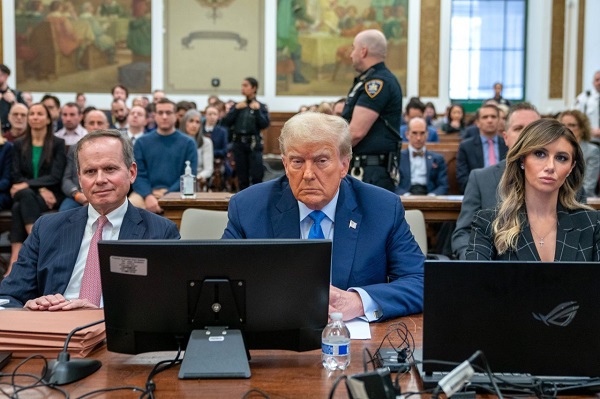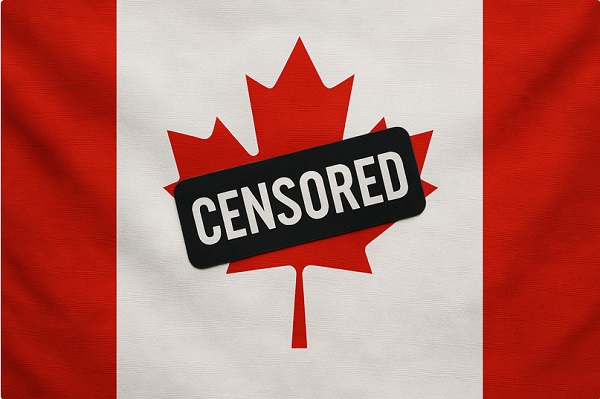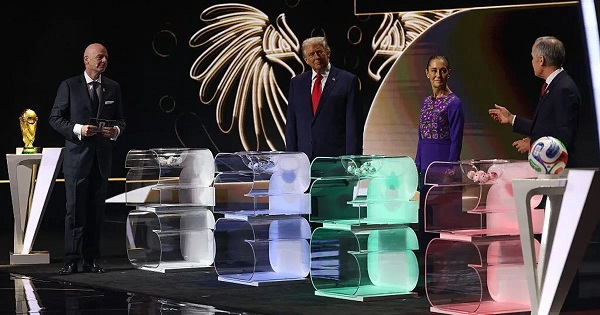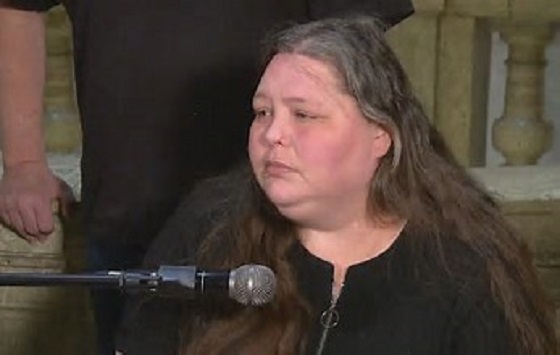Frontier Centre for Public Policy
Trump’s trial defines justice in disrepute – A Canadian perspective

From the Frontier Centre for Public Policy
Canada and the US both have a problem with rogue judges
Whatever one thinks of former President Donald Trump, his criminal trial violates the jurisprudence established by England’s Lord Chief Justice Hewart: “It is… of fundamental importance that justice should not only be done, but should manifestly and undoubtedly be seen to be done.”
Judges too often preside over cases despite having a conflict of interest. Trump’s argument had merit, that having the Democrat stronghold of Manhattan as the venue for his trial was unfair. And the assignment of Acting Justice Juan Merchan for the trial may reasonably be said to be corrupt. The US Judicial Code says: “Any justice, judge, or magistrate judge of the United States shall disqualify himself in any proceeding in which his impartiality might reasonably be questioned.”
Republican Congresswoman Elise Stefanik says Justice Merchan contributed to the Democrat campaign in 2020. And his daughter, Loren Merchan, is heavily involved in Democrat politics. Stefanik says her firm stood to profit from Trump’s conviction. So, one may presume the judge’s bias against Trump.
The charge against Trump was that money was paid to porn star Stormy Daniels to keep her quiet and not undermine his presidential election prospects in 2016. Paying money to suppress prurient assertions is not illegal. But, it was said to violate US election law if intended to influence the outcome of the election—and not merely to protect Trump’s reputation. Given what everyone knows, how could publication of Daniels’s assertions influence a single voter’s intentions?
Many other wandering public figures come to mind. Certainly, Presidents Kennedy and Clinton. Said to be expert on the bedroom ceilings of rich men, Pamela Digby Churchill Hayward Harriman was Clinton’s ambassador to France.
Textbooks and case law forbid judges to hear cases where there could be a perception of bias. A landmark case involved an application by the Spanish government to extradite former President Pinochet of Chile from England. Lord Hoffmann was the swing vote in the decision that immunity did not prevent extradition. The House of Lords set aside that judgment because Lord Hoffmann had been chairman of Amnesty International, which had campaigned for Pinochet’s prosecution. The judges said that the Amnesty link was an automatic disqualification for sitting on the case.
During the 2022 truckers’ protest in Ottawa, Chief Justice Richard Wagner made outlandish comments about an incipient revolution. The Canadian Judicial Council, of which he is head, exonerated him. By contrast, Justice Thomas Berger of the BC Supreme Court resigned gracefully after being scolded for non-partisan comment on the entrenchment of Indigenous rights in the Charter.
A typical case of conflicted judging is MediaTube v. Bell Canada, discussed at length in my book Justice on Trial. The plaintiff asserting that Bell stole the technology for FibeTV. The Federal Court’s trial judge, Justice George Locke, had been a partner in the firm of Norton Fulbright that acted for Bell. His decision in favour of Bell is gobbledygook. He acknowledged that Bell had constantly changed the description of how their system worked, as if they didn’t know that. Arguably, Bell and their lawyers McCarthy Tétrault committed the criminal offences of perjury and obstruction of justice. Justice David Stratas spoke for the appellate judges despite having previously represented Bell before the Supreme Court. In 130 words, he justified the exclusion of new evidence by citing a case that had analyzed the purported new evidence in 9,000 words.
Trump’s case follows ones described in Christie Blatchford’s book, Life Sentence: Stories from four decades of court reporting—Or how I fell out of love with the Canadian justice system (Especially judges). “The judiciary,” she wrote, “is much like the Senate. Like senators they are unelected, unaccountable, entitled, expensive to maintain and remarkably smug.”
Canadians as well as Americans need outside accountability for lawyers and judges. As US Supreme Court Justice Louis Brandeis once wrote, “If we desire respect for the law, we must first make the law respectable.”
Colin Alexander’s degrees include Politics, Philosophy, and Economics from Oxford. His latest book is Justice on Trial: Jordan Peterson’s case shows we need to fix the broken system.
Censorship Industrial Complex
Ottawa’s New Hate Law Goes Too Far

From the Frontier Centre for Public Policy
By Lee Harding
Ottawa says Bill C-9 fights hate. Critics say it turns ordinary disagreement into a potential crime.
Discriminatory hate is not a good thing. Neither, however, is the latest bill by the federal Liberal government meant to fight it. Civil liberties organizations and conservative commentators warn that Bill C-9 could do more to chill legitimate speech than curb actual hate.
Bill C-9 creates a new offence allowing up to life imprisonment for acts motivated by hatred against identifiable groups. It also creates new crimes for intimidation or obstruction near places of worship or community buildings used by identifiable groups. The bill adds a new hate propaganda offence for displaying terrorism or hate symbols.
The Canadian Civil Liberties Association (CCLA) warns the legislation “risks criminalizing some forms of protected speech and peaceful protest—two cornerstones of a free and democratic society—around tens of thousands of community gathering spaces in Canada.” The CCLA sees no need to add to existing hate laws.
Bill C-9 also removes the requirement that the Attorney General consent to lay charges for existing hate propaganda offences. The Canadian Constitution Foundation (CCF) calls this a major flaw, noting it removes “an important safeguard for freedom of expression that has been part of Canada’s law for decades.” Without that safeguard, decisions to prosecute may depend more on local political pressures and less on consistent national standards.
Strange as it sounds, hatred just will not be what it used to be if this legislation passes. The core problem begins with how the bill redefines the term itself.
Previously, the Supreme Court of Canada said hatred requires “extreme manifestations” of detestation or vilification that involve destruction, abhorrence or portraying groups as subhuman or innately evil. Instead, Bill C-9 defines hatred as “detestation or vilification,” stronger than “disdain or dislike.” That is a notably lower threshold. This shift means that ordinary political disagreement or sharp criticism could now be treated as criminal hatred, putting a wide range of protected expression at real risk.
The bill also punishes a hateful motivation more than the underlying crime. For example, if a criminal conviction prompted a sentence of two years to less than five years, a hateful motivation would add as much as an additional five years of jail time.
On paper, most Canadians may assume they will never be affected by these offences. In practice, the definition of “hate” is already stretched far beyond genuine threats or violence.
Two years ago, the 1 Million March for Children took place across Canada to protest the teaching of transgender concepts to schoolchildren, especially the very young. Although such opposition is a valid position, unions, LGBT advocates and even Newfoundland and Labrador Conservatives adopted the “No Space For Hate” slogan in response to the march. That label now gets applied far beyond real extremism.
Public pressure also shapes how police respond to protests. If citizens with traditional values protest a drag queen story hour near a public library, attendees may demand that police lay charges and accuse officers of implicit hatred if they refuse. The practical result is clear: officers may feel institutional pressure to lay charges to avoid being accused of bias, regardless of whether any genuine threat or harm occurred.
Police, some of whom take part in Pride week or work in stations decorated with rainbow colours in June, may be wary of appearing insensitive or intolerant. There have also been cases where residents involved in home invasion incidents were charged, and courts later determined whether excessive force was used. In a similar way, officers may lay charges first and allow the courts to sort out whether a protest crossed a line. Identity-related considerations are included in many workplace “sensitivity training” programs, and these broader cultural trends may influence how such situations are viewed. In practice, this could mean that protests viewed as ideologically unfashionable face a higher risk of criminal sanction than those aligned with current political priorities.
If a demonstrator is charged and convicted for hate, the Liberal government could present the prosecution as a matter for the justice system rather than political discretion. It may say, “It was never our choice to charge or convict these people. The system is doing its job. We must fight hate everywhere.”
Provincial governments that support prosecution will be shielded by the inability to show discretion, while those that would prefer to let matters drop will be unable to intervene. Either way, the bill could increase tensions between Ottawa and the provinces. This could effectively centralize political authority over hate-related prosecutions in Ottawa, regardless of regional differences in values or enforcement priorities.
The bill also raises concerns about how symbols are interpreted. While most Canadians would associate the term “hate symbol” with a swastika, some have linked Canada’s former flag to extremism. The Canadian Anti-Hate Network did so in 2022 in an educational resource entitled “Confronting and preventing hate in Canadian schools.”
The flag, last used nationally in 1965, was listed under “hate-promoting symbols” for its alleged use by the “alt-right/Canada First movement” to recall when Canada was predominantly white. “Its usage in modern times is an indicator of hate-promoting beliefs,” the resource insisted. If a historic Canadian symbol can be reclassified this easily, it shows how subjective and unstable the definition of a “hate symbol” could become under this bill.
These trends suggest the legislation jeopardizes not only symbols associated with Canada’s past, but also the values that supported open debate and free expression. Taken together, these changes do not merely target hateful behaviour. They create a legal framework that can be stretched to police dissent and suppress unpopular viewpoints. Rest in peace, free speech.
Lee Harding is a research fellow for the Frontier Centre for Public Policy.
Business
Canada Can Finally Profit From LNG If Ottawa Stops Dragging Its Feet

From the Frontier Centre for Public Policy
By Ian Madsen
Canada’s growing LNG exports are opening global markets and reducing dependence on U.S. prices, if Ottawa allows the pipelines and export facilities needed to reach those markets
Canada’s LNG advantage is clear, but federal bottlenecks still risk turning a rare opening into another missed opportunity
Canada is finally in a position to profit from global LNG demand. But that opportunity will slip away unless Ottawa supports the pipelines and export capacity needed to reach those markets.
Most major LNG and pipeline projects still need federal impact assessments and approvals, which means Ottawa can delay or block them even when provincial and Indigenous governments are onside. Several major projects are already moving ahead, which makes Ottawa’s role even more important.
The Ksi Lisims floating liquefaction and export facility near Prince Rupert, British Columbia, along with the LNG Canada terminal at Kitimat, B.C., Cedar LNG and a likely expansion of LNG Canada, are all increasing Canada’s export capacity. For the first time, Canada will be able to sell natural gas to overseas buyers instead of relying solely on the U.S. market and its lower prices.
These projects give the northeast B.C. and northwest Alberta Montney region a long-needed outlet for its natural gas. Horizontal drilling and hydraulic fracturing made it possible to tap these reserves at scale. Until 2025, producers had no choice but to sell into the saturated U.S. market at whatever price American buyers offered. Gaining access to world markets marks one of the most significant changes for an industry long tied to U.S. pricing.
According to an International Gas Union report, “Global liquefied natural gas (LNG) trade grew by 2.4 per cent in 2024 to 411.24 million tonnes, connecting 22 exporting markets with 48 importing markets.” LNG still represents a small share of global natural gas production, but it opens the door to buyers willing to pay more than U.S. markets.
LNG Canada is expected to export a meaningful share of Canada’s natural gas when fully operational. Statistics Canada reports that Canada already contributes to global LNG exports, and that contribution is poised to rise as new facilities come online.
Higher returns have encouraged more development in the Montney region, which produces more than half of Canada’s natural gas. A growing share now goes directly to LNG Canada.
Canadian LNG projects have lower estimated break-even costs than several U.S. or Mexican facilities. That gives Canada a cost advantage in Asia, where LNG demand continues to grow.
Asian LNG prices are higher because major buyers such as Japan and South Korea lack domestic natural gas and rely heavily on imports tied to global price benchmarks. In June 2025, LNG in East Asia sold well above Canadian break-even levels. This price difference, combined with Canada’s competitive costs, gives exporters strong margins compared with sales into North American markets.
The International Energy Agency expects global LNG exports to rise significantly by 2030 as Europe replaces Russian pipeline gas and Asian economies increase their LNG use. Canada is entering the global market at the right time, which strengthens the case for expanding LNG capacity.
As Canadian and U.S. LNG exports grow, North American supply will tighten and local prices will rise. Higher domestic prices will raise revenues and shrink the discount that drains billions from Canada’s economy.
Canada loses more than $20 billion a year because of an estimated $20-per-barrel discount on oil and about $2 per gigajoule on natural gas, according to the Frontier Centre for Public Policy’s energy discount tracker. Those losses appear directly in public budgets. Higher natural gas revenues help fund provincial services, health care, infrastructure and Indigenous revenue-sharing agreements that rely on resource income.
Canada is already seeing early gains from selling more natural gas into global markets. Government support for more pipelines and LNG export capacity would build on those gains and lift GDP and incomes. Ottawa’s job is straightforward. Let the industry reach the markets willing to pay.
Ian Madsen is a senior policy analyst at the Frontier Centre for Public Policy.
-

 Bruce Dowbiggin8 hours ago
Bruce Dowbiggin8 hours agoWayne Gretzky’s Terrible, Awful Week.. And Soccer/ Football.
-

 espionage11 hours ago
espionage11 hours agoWestern Campuses Help Build China’s Digital Dragnet With U.S. Tax Funds, Study Warns
-

 Agriculture7 hours ago
Agriculture7 hours agoCanada’s air quality among the best in the world
-

 Business9 hours ago
Business9 hours agoCanada invests $34 million in Chinese drones now considered to be ‘high security risks’
-

 Economy10 hours ago
Economy10 hours agoAffordable housing out of reach everywhere in Canada
-

 Fraser Institute2 days ago
Fraser Institute2 days agoClaims about ‘unmarked graves’ don’t withstand scrutiny
-

 Energy2 days ago
Energy2 days agoMeet REEF — the massive new export engine Canadians have never heard of
-

 Alberta2 days ago
Alberta2 days agoHere’s why city hall should save ‘blanket rezoning’ in Calgary



